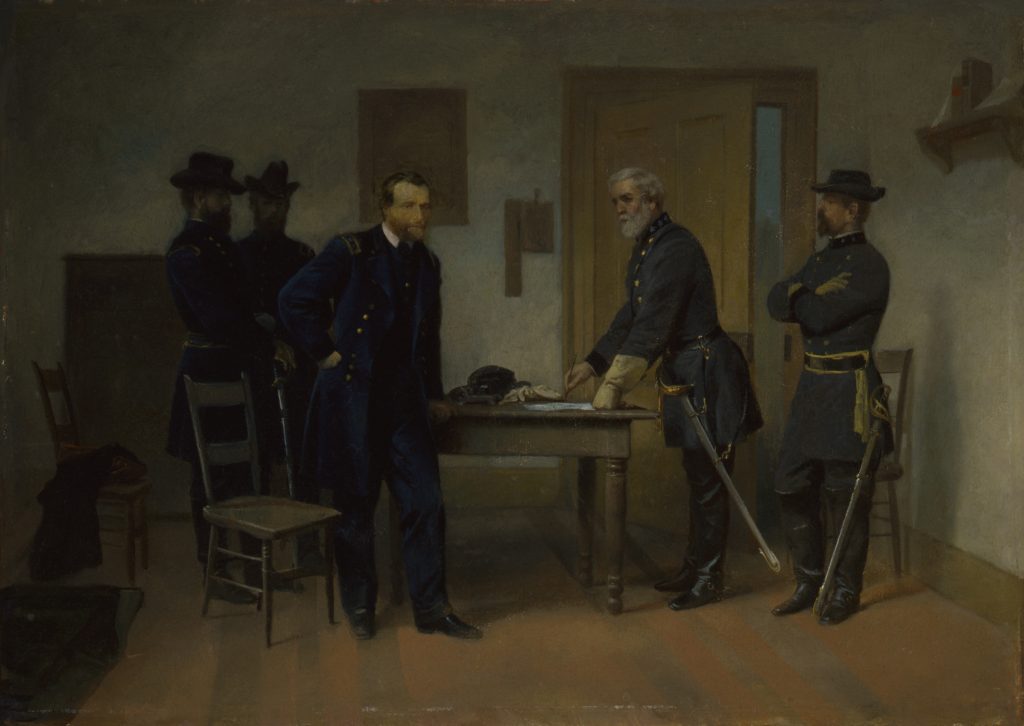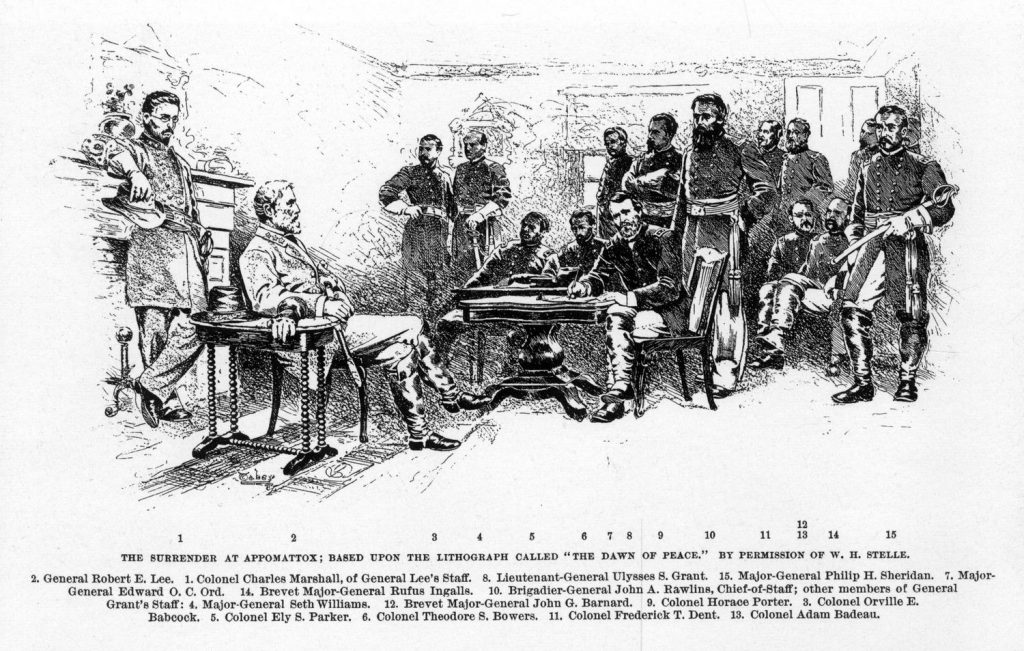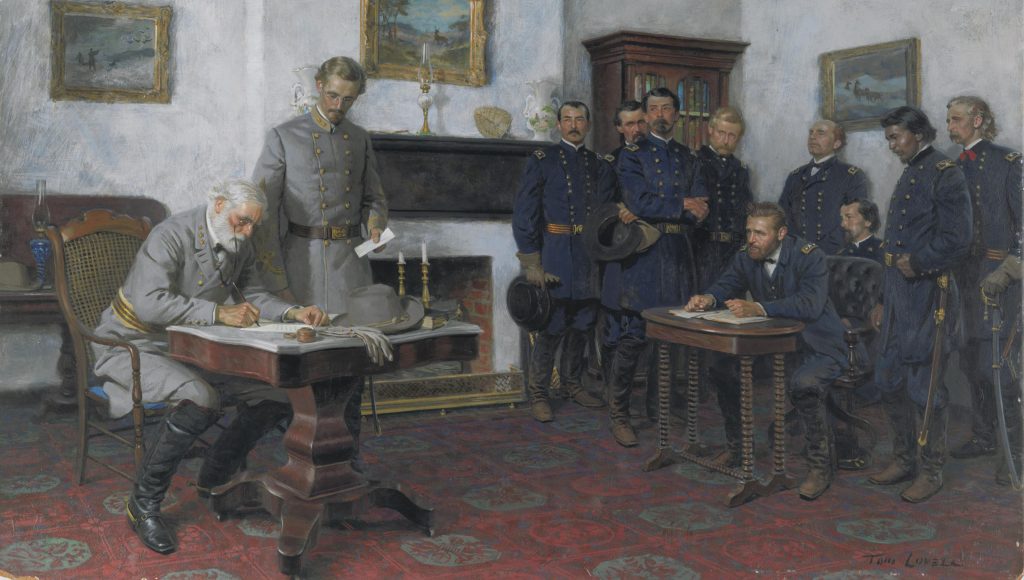Picturing Union Victory – Early Images of the Surrender at Appomattox
Here’s a familiar story: On April 9, 1865, generals Ulysses S. Grant and Robert E. Lee met in Wilmer McLean’s parlor at Appomattox Courthouse to sign the documents that would dictate the surrender of the most important national institution in the Confederacy—the Army of Northern Virginia. Grant sat at a small wooden table with spindle-turned legs and an oval top. His aide, Lt. Col. Ely S. Parker, sat at another small wooden table in order to write out copies of the surrender. Lee sat at a much grander table, with a large black wooden base and a marble top. It’s very probable that neither general made much of the seating arrangements (Grant, in fact, fails to describe them in his memoirs); but that has not prevented them from being the subject of much controversy and conversation in the fifteen decades since.
Over the past few weeks I have been asking myself why so many early images produced of the scene in Wilmer McLean’s parlor seem to get so many details about the war’s most important surrender wrong. As a historian, trained to analyze sources and inspect their biases—as well as to understand how history and memory overlap and differ—I formed a hypothesis that images produced closer to April 9, 1865 would be more reliable than those that came after many of the participants had died or those that were created during the centennial and sesquicentennial celebrations of the event. A brief test of my hypothesis revealed just how wrong I was and I had to set off to answer a new question: why are so many early images of the surrender wrong and what are they trying to tell viewers?
I became particularly concerned by the failure of early artists to assign Grant and Lee to the correct tables. As will be seen below, the earliest images of the surrender take two approaches—they either depict Grant and Lee sharing a single table or they swap the positions of the two most important commanders—putting Grant at the larger, marble-topped table. This phenomenon leads me to believe that many of the earliest images of the Appomattox surrender were created to celebrate the victory of the United States in the Civil War, not to provide accurate historical evidence. Hence, there is a strong pro-Union bias in early Appomattox imagery.
Early images either strive to make Ulysses S. Grant and the Union cause appear more important by placing him at the grander table and surrounding him with his most important officers (regardless of whether they were actually present at the surrender); or they emphasize Grant’s humanity and belief in reconciliation by suggesting that he met Lee and shared a table with the Confederate officer, acting in such a way that would encourage all Union soldiers and Northern citizens to be magnanimous in victory.
I will use three examples to illustrate my hypothesis:

Alonzo Chappel, an American painter whose life spanned the Civil War, made two attempts at portraying the events of Appomattox. Best known today as a painter of the Revolutionary War, Chappel’s first Appomattox painting depicted Lee and Grant sharing a large wooden table. The painting now greets visitors in the Smithsonian American Art Museum. The image makes clear that Grant is the victor but does not overawe the audience with the superiority of the Union. It is an image that promotes reconciliation—but, critically, reconciliation on Grant’s terms.
A second Chappel rendering, which scholars Barbara J. Mitnick and David Meschutt identify as the artist’s effort “paint a new and more accurate version of the surrender”[i] shows the two most famous tables in recognizable form—but places the two principal participants at the wrong ones. Grant still dominates the frame, surrounded by many of the luminaries of the Union high command. Parker sits at a third table—identical to Lee’s. The image directs viewers to notice that Grant and his fellow officers are watching Lee intently and Grant appears comfortably in charge of events.

Chappel’s painting could also be viewed as the artist’s commentary on the success of the army’s interventions in watching over the former Confederacy during Reconstruction. The entire focus of the Union high command is on Lee and his aide, Charles Marshall, just as the primary focus of the Regular Army would shift to maintaining peace and order across the Reconstruction South in the decade after the Civil War. Regardless of any Reconstruction commentary Chappel’s contemporary image clearly celebrates the achievements of Grant and his subordinates during the war.

More Americans were likely to have to have seen the illustration that accompanied the Century Publishing Company’s Battles and Leaders history of the Civil War than any other Appomattox image. The image hews closely to Chappel’s second painting and switches the tables for Lee and Grant—placing the Union commander at the more ostentatious of the two. Phillip Sheridan is given more to do—and points his sword at Lee, perhaps suggesting the superiority of Union arms as Lee’s sword is barely visible and reminding viewers that Sheridan’s army had been critical to pinning Lee’s dwindling forces down near Appomattox Courthouse (especially at Five Forks) as the Confederate force made its retreat from its Petersburg lines.
The choice to include Sheridan is a further indication of the lithograph’s pro-Union point of view. Historical accounts differ on whether “Little Phil” was in the McLean parlor on April 9, though Sheridan himself told artist James E. Kelly in 1878 that he was not in the room during the negotiations (he claimed in his interview with Kelly to have been napping under a tree in McLean’s front yard).[ii] In his 1888 memoirs Sheridan changed his story and explained he had been in the room for portions of the surrender, but that during the discussion of the surrender conditions only Grant, Lee, Marshall, and Parker were present.[iii] By including the full cast of participants alongside the principal players, early Union lithographs emphasized the might of the Union army and the numerical differences between the two major combatants in the war’s Eastern Theater.
In looking at Appomattox imagery it is striking to note that one of the few historical details the Lost Cause memory of the Civil War got correct is the seating arrangements in the McLean parlor. While not explicitly a Lost Cause document, Tom Lovell’s “Surrender at Appomattox” (painted at the culmination of the war’s centennial in 1965) depicts Robert E. Lee at the center of the surrender. Light, presumably emanating from a window to the viewer’s left but not visible in the painting, illuminates Lee. The gold sash on his spotless uniform stands out in contrast to the more muted detail of the Union officers present. Grant, meanwhile, hunches over (the correct) small table in the shadowy background, his muddy boots offering another point of contrast to Lee’s polished footwear. The most noticeable Union officer is arguably George Armstrong Custer (who was not present in the room), due to the splash of red on his kerchief.

Despite correcting small details these Lost Cause-leaning images still celebrate the losing side in the war—and an Appomattox image that properly renders the details of the parlor and emphasizes Union victory would be of great value to historians and visitors to Civil War sites across the country. And while my original hypothesis turned out to be incorrect, my ensuing adventure through Appomattox imagery revealed early celebrations of the Union cause and depictions of Ulysses S. Grant as his contemporaries viewed him. While not particularly useful in crafting a historical narrative they are potent reminders of how the Civil War generation set about the work of memory making and how the Lost Cause came to displace the robust efforts of Union memorialists in the decades after the Civil War.
[i] Barbara J. Mitnick and David Meschutt, The Portraits and History Paintings of Alonzo Chappel (Brandywine River Museum, 1992), 84.
[ii] William B. Styple, ed., Generals in Bronze: Interviewing the Commanders of the Civil War (Kearny, N.J.: Belle Grove Publishing 2005), 4-5.
[iii] Phillip H. Sheridan, Personal Memoirs of P. H. Sheridan, 2 vols. (New York: Charles H. Webster and Company, 1888), 2:200-1.
I am still amazed at how the “Lost Cause’ became so influencing in affecting things!
Well-done. The 1907 card was probably done for Lee’s birth centenary.
I’ve never heard or read that any journalists/reporters were allowed in as the surrender activities unfolded. Details had to be gotten after the fact, and thus details invariably differed from source to source. AND, as the article itself points out, there was often a propaganda element at work, even well after the event transpired.
A very interesting approach to determining “the facts” at Appomattox. Why did you exclude the first painting of Chappel? Who was really present?—Lee and Marshal and Grant and Parker are the most certain based on your work. The remaining Union contingent seems to depend on the artist’s choice (or his funding source ). I admire greatly your willingness to reject your initial hypothesis. Is it likely that only 4 were there for the entire event, and a few other Union officers were periodic “gatecrashers”?
Best wishes in your career.
I don’t think the 1965 Lovell. Is “Lost Cause-leaning”. If it is, I don’t believe it is because Lee’s sash stands out on his spotless uniform, and Grant doesn’t look as grand with mud on his boots. But that is accurate. Lee showed up that day dressed to the nines because he believed he would be taken prisoner and he wanted to look stately and elegant when taken prisoner, and Grant wanted to be dressed better, but was in too much of a scramble getting there and he didn’t get the chance to dress himself better and clean his boots. I think even made a comment to an aide about wishing he had the chance to clean himself up. Interesting write up, and I should note, I know nothing bout Lovell or his work, just wanted to point out that those details are not to embellish the South, or the ‘Lost Cause’, but were accurate representations of the day, even if the officers present are not accurate.